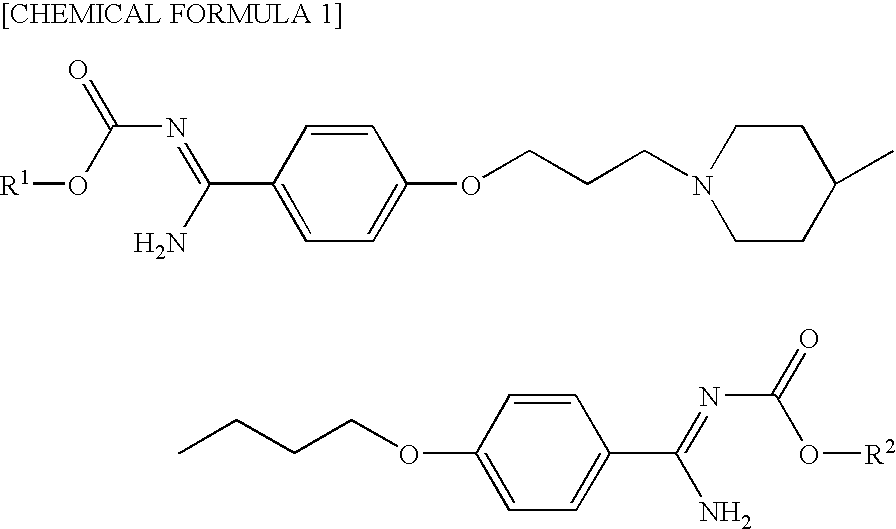Pharmaceutical composition comprising phenylamidine derivative and method of using the pharmaceutical composition in combination with antifungal agent
- Summary
- Abstract
- Description
- Claims
- Application Information
AI Technical Summary
Benefits of technology
Problems solved by technology
Method used
Image
Examples
reference example 1
[0083]
[0084]To tetrahydrofuran 10 mL solution of propanol 0.75 g and triethylamine 1.90 mL, a tetrahydrofuran 15 mL solution of 4-nitrophenyl chloroformate 2.50 g was dropped under ice-cooling. Ethyl acetate and water were added to the reaction mixture after stirring at room temperature for 20 minutes. After organic layer was separated, collected and washed with water and a saturated aqueous sodium chloride solution sequentially, the organic layer was dried over anhydrous magnesium sulfate, and followed by distilling off the solvent. After hexane was added to the residue, filtration of insolubles and removal of the solvent under reduced pressure yielded 4-nitrophenyl propylcarbonate 2.59 g as light yellow oil.
[0085]1H-NMR (CDCl3) δ value: 1.03 (3H, t, J=7.4 Hz), 1.71-1.85 (2H, m), 4.26 (2H, t, J=6.7 Hz), 7.39 (2H, d, J=9.0 Hz), 8.28 (2H, d, J=9.0 Hz)
reference example 2
[0086]
[0087]To tetrahydrofuran 30 mL solution of 4-nitrophenol 3.00 g and triethylamine 3.31 mL, isopropyl chloroformate 2.46 mL was dropped under ice-cooling. Ethyl acetate and water were added to the reaction mixture after stirring at the same temperature for 10 minutes. After organic layer was separated, collected and washed with a saturated aqueous sodium chloride solution, the organic layer was dried over anhydrous magnesium sulfate, followed by distilling off the solvent under reduced pressure. After the residue was dissolved in 50 ml of ethyl acetate and washed with 5% aqueous solution of potassium carbonate and a saturated aqueous sodium chloride solution sequentially, the organic layer was dried over anhydrous magnesium sulfate and followed by distilling off the solvent under reduced pressure to yield 4-nitrophenyl isopropylcarbonate 3.00 g as a light yellow solid.
[0088]1H-NMR (CDCl3) δ value: 1.41 (6H, d, J=6.3 Hz), 4.96-5.07 (1H, m), 7.36-7.41 (2H, m), 8.25-8.30 (2H, m)
reference example 3
[0089]
[0090]To tetrahydrofuran 30 mL solution of 4-nitrophenol 3.00 g and triethylamine 3.31 mL, butyl chloroformate 2.75 mL was dropped under ice-cooling. Ethyl acetate and water were added to the reaction mixture after stirring at the same temperature for 10 minutes. After organic layer was separated, collected and washed with a saturated aqueous sodium chloride solution, the organic layer was dried over anhydrous magnesium sulfate and followed by distilling off the solvent to yield 4-nitrophenyl butylcarbonate 4.60 g as light yellow oil.
[0091]1H-NMR (CDCl3) δ value: 0.99 (3H, t, J=7.4 Hz), 1.41-1.52 (2H, m), 1.70-1.80 (2H, m), 4.30 (2H, t, J=6.6 Hz), 7.36-7.41 (2H, m), 8.26-8.31 (2H, m)
PUM
| Property | Measurement | Unit |
|---|---|---|
| Angle | aaaaa | aaaaa |
Abstract
Description
Claims
Application Information
 Login to View More
Login to View More - R&D
- Intellectual Property
- Life Sciences
- Materials
- Tech Scout
- Unparalleled Data Quality
- Higher Quality Content
- 60% Fewer Hallucinations
Browse by: Latest US Patents, China's latest patents, Technical Efficacy Thesaurus, Application Domain, Technology Topic, Popular Technical Reports.
© 2025 PatSnap. All rights reserved.Legal|Privacy policy|Modern Slavery Act Transparency Statement|Sitemap|About US| Contact US: help@patsnap.com



